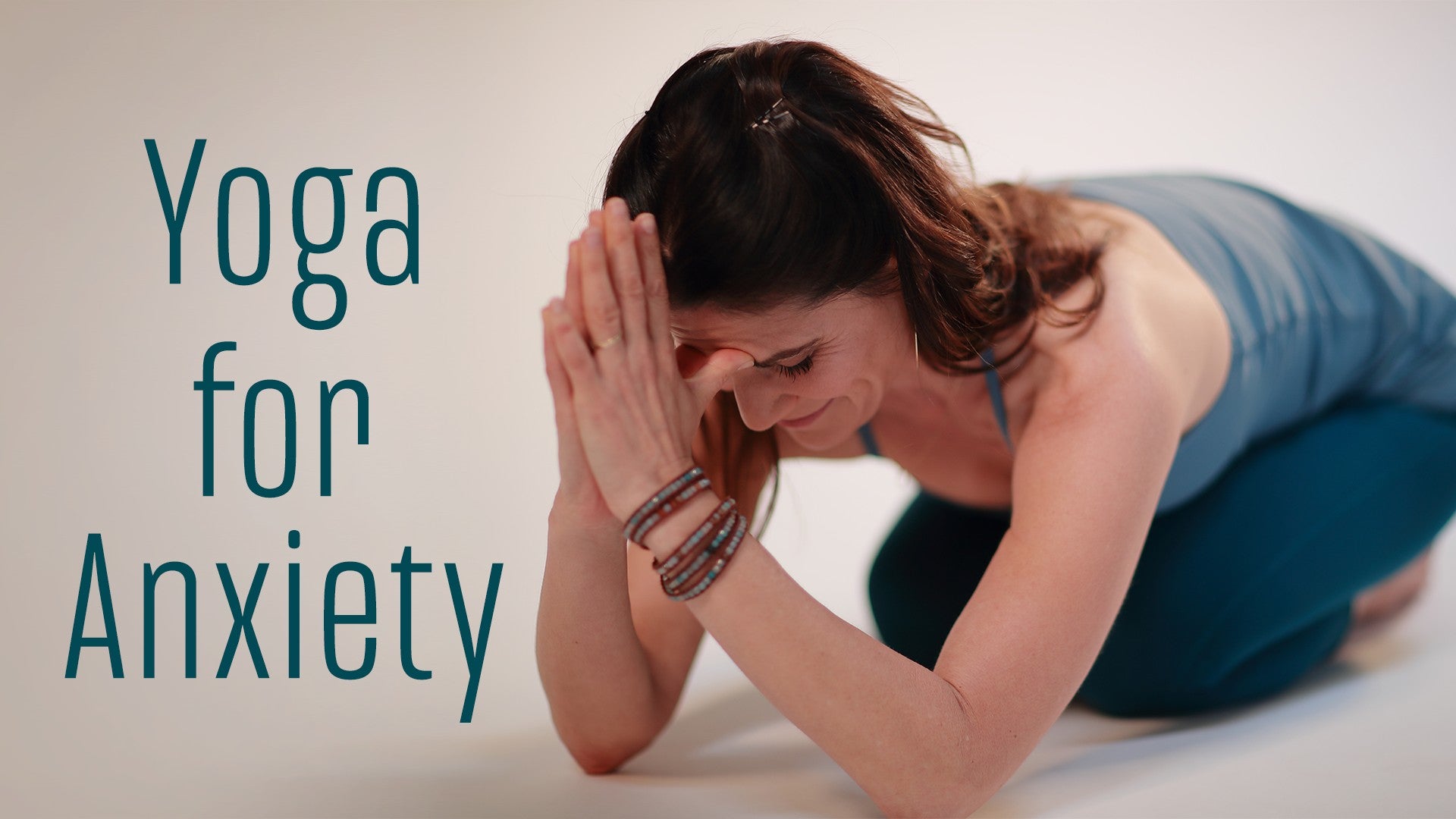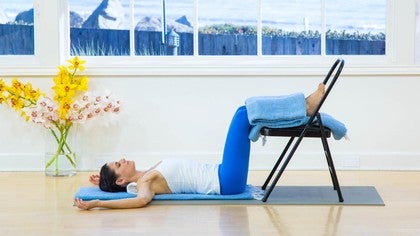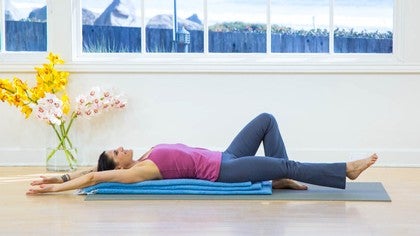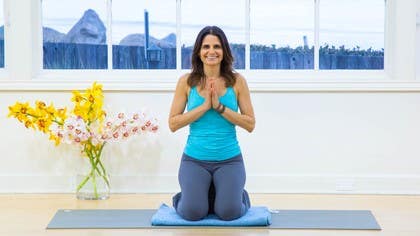Description
About This Video
Transcript
Read Full Transcript
Welcome to the restorative practice, legs up a chair. This is the perfect practice to help you feel more grounded and to slow down, but it's also really great to reduce stress and even anxiety because this shape that we're going to make allows a muscle in our body called the psoas muscle to be in a position where it can release deeply held tension. And why that's important in relationship to stress and anxiety is when we feel threatened, when we don't feel okay, for whatever reason, the moment we start to feel nervous and not at ease, in one-twentieth of a second, the time between two heartbeats, we get this stress response and the very first muscle to get the message that it needs to protect us is the psoas. So repeatedly, every time we feel stressed, we get this taught tense reaction in the psoas that prepares us very wisely to fight or flee. However, when it's getting that message all day long, it becomes chronically short and it pulls on our body into this position almost like a sprinter at a starting line.
As it pulls and shortens and grows tense, it not only affects the digestive organs and the reproductive organs creating a tighter, more compromised environment, but it also pulls on the spine and it pulls on the spine, minimizing the movement of the spine as we breathe. It also pulls on the spine in a way that literally minimizes breathing because it minimizes the movement of the diaphragm. What I mean by that is where the diaphragm connects to the spine is the same area where the psoas connects to the spine. So a tight psoas not only leads to low back pain and discomfort and overall achiness, but it minimizes our breath. When the breath grows short and shallow, it continues to send a message to our brain that we need to protect ourselves more.
So we have this loop from our brain. We fire up the psoas to protect ourselves. When the psoas is chronically tight, we continue to tell our brain that we're not safe. This is a wonderful pose to interrupt that conversation. It's very simple.
You can do it anywhere that you have a chair. And if you have a few other props, it's really nice, but you don't need these extra props that I'm going to show you how to use should you wish to use them. We're going to put a blanket up on the chair. And for me, that's just for cushion or maybe height to help the height of your legs. A second blanket for weight over the shins that makes it feel really grounded.
I'm laying down on a blanket, not only because it feels soft underneath my back and puts me more at ease, but it will also help me feel cushioned underneath my head. I personally really enjoy a neck roll, and that's optional as well. It'll be right underneath my cervical curve. To begin, have your blanket for your legs nearby. Sit side saddle to your chair, and very slowly you're going to come down onto your forearm so that you can bring one leg up at a time.
Bring your back down. Actually, before you bring your back down, you can take a moment to put the additional weight on your shins. And then come down in a way. If you need, place your neck roll so it's right underneath the cervical spine. You can wiggle around until you get it just right for you.
Your kneecaps see the sky. Arrange your shoulder blades so you feel flat on your back. Arms can be placed on your belly or by your side body. Sometimes you may wish to experiment with bringing your arms up by your side, but know that that's going to be a little bit more stimulating. So if you choose that, at least try other arm positions too to make sure you know which one you want to choose to create a particular feeling of either more quietness or maybe a little bit more expansiveness.
As we begin to settle in, I'm going to guide you through about 10 minutes of stillness in this pose. If you need to come out earlier, simply take your time to roll to your side and pause on your side body. To begin, take a few long breaths out through the mouth. Simply exaggerate your breath gently just a little longer than natural. Then as you begin to allow your breath to grow more natural, bring your attention to where your shins meet support.
And practice allowing your shins to be on the chair completely. No effort in your calf muscles, no work. Allow your thigh muscles to let go of any work they may be still doing, any gripping. Maybe even imagine your thigh muscles softening or melting away from the bone. You can imagine your thigh bones dropping back down into your pelvis, allowing your belly to soften, your thighs, your groins, and your belly to soften.
Exhale, thighs soften, groins soften, no work in the groin, belly softens so that you can allow more of your pelvis weight to drop heavily onto the ground. You can imagine if you were lying on soft earth, maybe sand or just earth that would take your print, allow the print of your pelvis to be received by the soft earth. Your belly pulls into your back and drains down into the ground. Effortless legs, effortless belly, effortless pelvis. You bring your awareness along your spine on the ground, feeling your back spread into its outline.
Maybe imagine your lungs resting on the floor. As you exhale, imagine your lungs at rest on the floor. Your heart at rest on the floor. Your whole back body spreading on the ground. Pelvis at rest, pelvis at rest, the whole back spreading on the ground.
Bring your shoulders and upper back carried by the floor. As you exhale, release any effort you might find in the corners of your chest, inside your shoulders, any way you might be resisting the support of the ground, in your shoulders might you be resisting the support that the ground is offering. Can you allow yourself to rest on support more? Feeling the whole upper back on the ground spreading onto the support of the earth. The earth will hold you up, so you can offer your head to the ground.
Can imagine your head being received by the soft earth, sort of the print of your head being received by the cradle of the earth. Whole back body from your calves to your head dropping onto support. You begin to bring your awareness to your face, you could soften all the muscles around your eyes so that there's no squinting anywhere. The eyelids drape softly on your eyes. Those of your eyes soft, the space between your brows widens and your brows slide towards your temples, your temples slide towards your ears and your ears slide to the ground.
Allow your eyes to fill your sockets, just let your eyes be free to fill your sockets. Your roof of your mouth soft, feel the space inside your tongue, voluminous tongue. The volume inside your lips and your tongue. Imagine the space between your breastbone and your back, just allow the breath to soften the space between your breastbone and your back. Allow your heart to fill your chest.
It fills your chest. Let your breath soften the space between your navel and your back. Simply free to fill your abdomen. And just for a moment we'll rest a little more quietly for a few breaths, I'll back out my guidance and simply practice allowing the support to hold you up. The ground longs to hold you so your breath has more room to fill you.
Let the ground hold you and the breath soften you. Let the ground hold you and the breath soften you. And you can linger here if you wish. When you're ready to move, take a moment to bring your arms by your side in the shape of a goal post or a cactus, if you haven't done that. Just to have a few expansive breaths, you can exaggerate your breath on purpose a little longer than natural, exhaling out your mouth.
If you'd like to wiggle through your fingers and toes or stretch your arms longer, feel free to do that. Any wiggles that feel good to you as you begin to stretch through your whole body, like you're waking up out of bed in the morning, then take your time to remove the blanket from your legs if you have one there. Very gently, mindfully, to retain the level of deep relaxation that we just went into. Make sure your movement is mindful, the transition is slow as you bring your feet off your chair. Share of all your props so that you gracefully transition without hitting anything.
You can roll to your side, your right side, making a pillow out of your right arm. Place your head on your arm and pause on your side body for several minutes or just a few moments. And when you're ready, again, to transition to sitting, gather your belly. We've been deeply released, so you want to make sure you feel firm in your belly and strong in your arms to slowly press up to sitting and pause in an easeful seat. Take a moment to reground yourself, dropping your weight from your head and shoulders all over again, down onto the earth.
Bringing your palms together in prayer, soften your head to your heart. May you feel more grounded and more at ease. May you feel able to move back into your life with more resources to stay calm and connected to your body and your breath. Thank you so much for practicing with me today. Namaste.
Yoga for Anxiety
Comments
You need to be a subscriber to post a comment.
Please Log In or Create an Account to start your free trial.
















